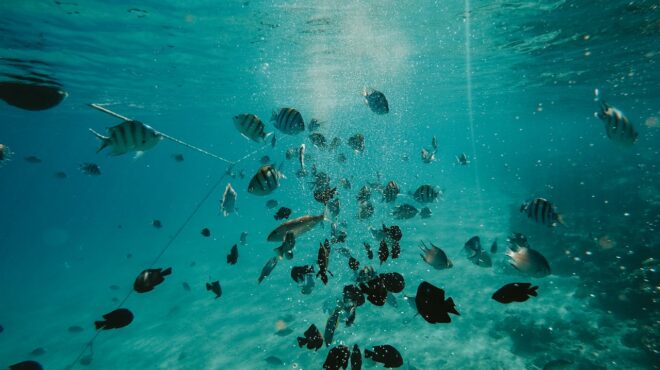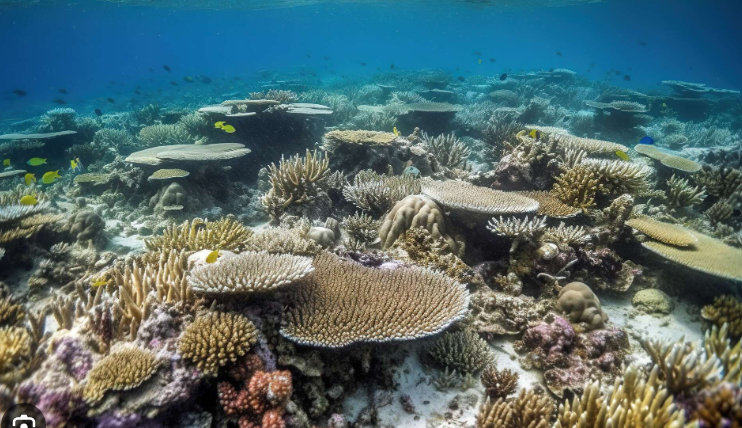All around the globe, since the 1950s, oceans have been losing oxygen. The number of coastal sites whose oxygen concentrations are too low to support marine life has increased from 10 in 1960 to more than 900 in 20181. And this loss is directly linked to human activity: water pollution (notably via fertilizers or wastewater, which contain phosphorus, nitrogen and organic matter, etc.) and, increasingly, global warming. This modifies the concentration of oxygen in water and marine currents, it causes the loss of biodiversity, increases the risk of overfishing and transforms biogeochemical and microbial processes in water (linked to the growth of emissions). of greenhouse gases (N2O and CH4)2). These changes in oxygen concentrations have a destructive impact on the ocean, its fauna and its flora; but it also concerns us, us humans, because this phenomenon impacts the millions of jobs linked to coastal waters, and the protein supply of more than 3 billion people3.
To protect this biodiversity, it is possible to install protected marine areas, reduce and control the runoff of nutrients and organic matter in coastal waters… But often, these measures do not have a direct influence on the rates. of oxygen or a very late influence. Since the 1980s, the United States has developed the artificial reoxygenation of fresh water reserves using pure oxygen. But this technique has never been used in the marine environment. In the years 2009-2012 two experiments took place in fjords in the Baltic Sea4: water was pumped near the surface (where it is better oxygenated than in the depths) and brought towards the depths. Unfortunately this technique proved to be too ineffective and too expensive to be considered on a large scale. There are therefore currently no effective measures to combat the loss of oxygen in coastal waters.
This situation could very likely change in the years to come, thanks to the development of offshore renewable energy production projects – in accordance with the objectives set by the European Union within the framework of the European Green Deal for 2030 and 2050 – and the development of green hydrogen production projects at sea which will be linked to it. The production of hydrogen therefore opens the way to a new source of oxygen in the coastal marine space.
Indeed, the production of renewable energies at sea will clearly be accompanied by the production of green hydrogen. The European maritime area has a wind source capable of replacing our entire gas and oil consumption. And if the cost of transporting electricity forces operators to position offshore wind turbines near the coast, transporting gas is not a difficulty. The production of hydrogen at sea therefore makes it possible to exploit the “farshore” wind resource. Germany and the Netherlands have already made this a goal.
Hydrogen production sites at sea will therefore be connected to wind farms installed more than 50/100 km from the coast, where the wind resources are good, and where there is no competition with the production of hydrogen. electricity, due to connection costs. The water electrolysis production system will thus be powered by sea water and renewable electricity from wind turbines, as the Sealhyfe (Lhyfe) experiment demonstrated that it was possible to do in 2023 .
However, to produce 1 kg of hydrogen by electrolysis of water, we co-produce 8 kg of oxygen. The offshore production sites will have a minimum unit power of 500 MW, i.e. a production of 200 tonnes of hydrogen per day, each site will therefore be able to produce at least 1,600 tonnes of oxygen each day. These offshore hydrogen production sites therefore represent a very significant potential oxygen source. This new source of oxygen now makes it possible to consider using the techniques used since the 1980s in fresh water to adapt them to the marine space. This opens up new and hopeful prospects for coastal ecosystems that urgently need help to combat this devastating oxygen loss.
However, the artificial reoxygenation of coastal marine spaces is a measure which, to be applied with responsibility and sustainability, needs to be prepared meticulously and in an interdisciplinary manner.
- At the scientific level: the exact effects on the entire local marine system and oxygen demand need to be monitored, analyzed and evaluated;
- At the technological level: the installations will be deployed in a very corrosive and hostile space;
- At the political level: the effects of reoxygenation can cross borders;
- At the socio-economic level: the installations can be visible from the coast, and they can change the breeding conditions and abundance of fish and other fished species in the region.
But beyond these considerations, all of the impacts on the ecosystem, biodiversity, physics and biogeochemistry of water need to be observed, controlled and adjusted to avoid any undesired consequences, and ensure that these processes really make it possible to provide a service to nature. This is why it is crucial to start on a small scale, in order to study reoxygenation in all its facets.
From a philosophical point of view we could also ask the question of the necessity and urgency of the implementation and exploration of artificial reoxygenation. UNESCO’s “Declaration of ethical principles relating to climate change”5 responds to this point: its articles 2 and 3 (on “Prevention of nuisances” and the “Precautionary principle”) directly concern solutions capable of combating against climate change and its implications. In this context, artificial reoxygenation of the oceans must be explored and implemented with care, responsibility and sustainability6.




